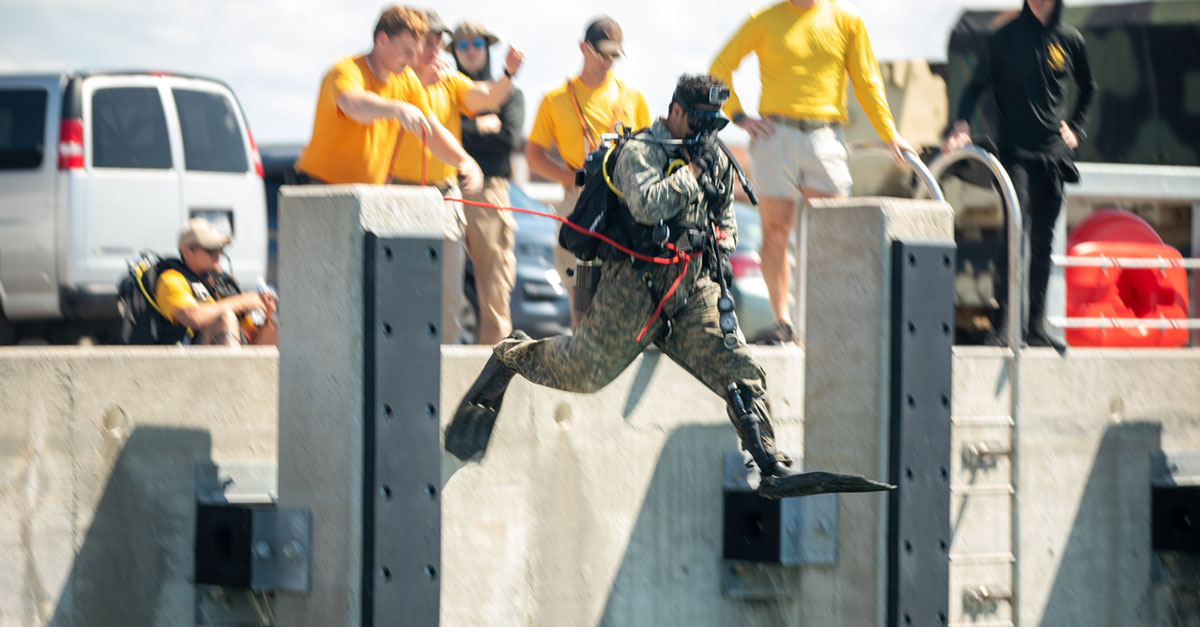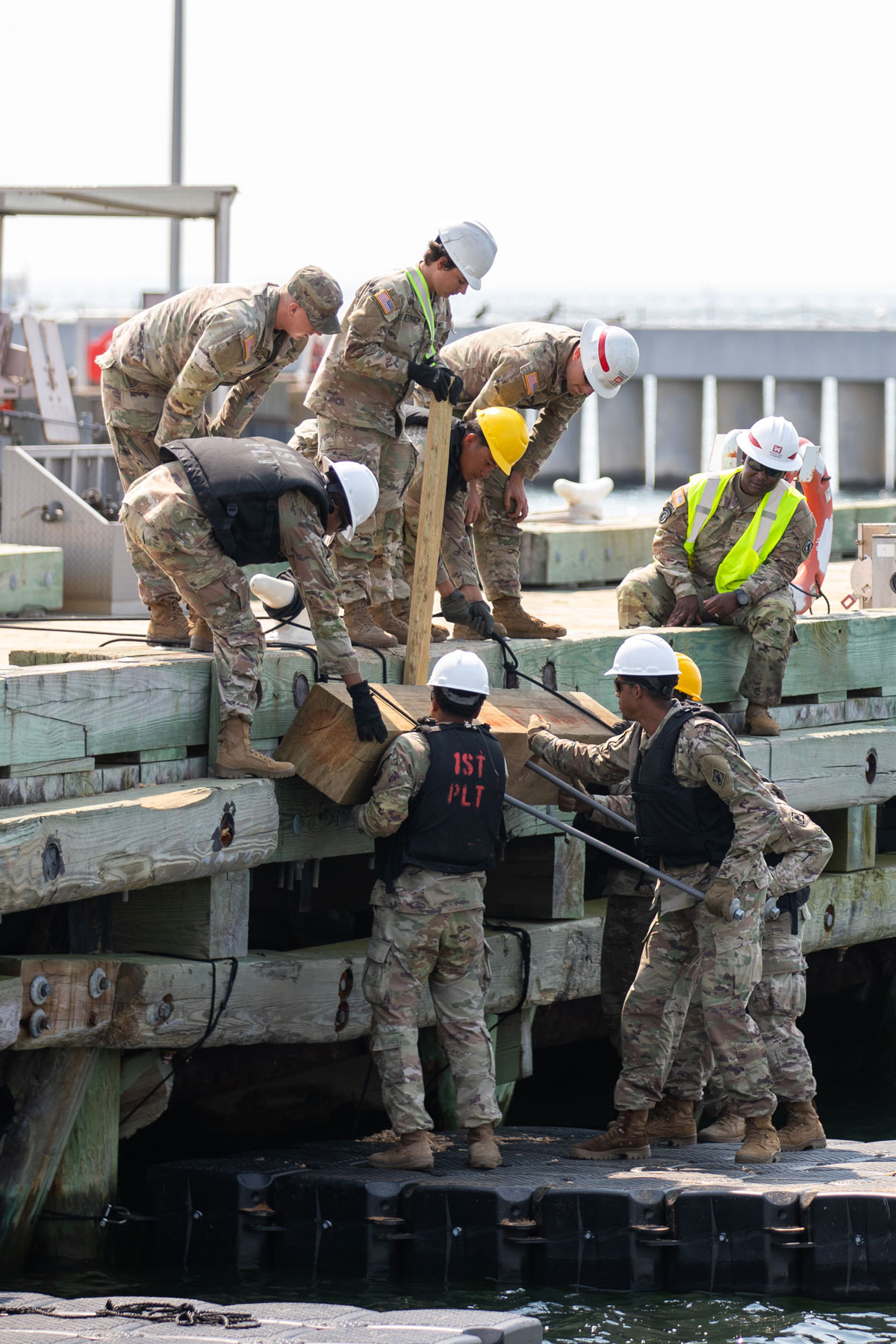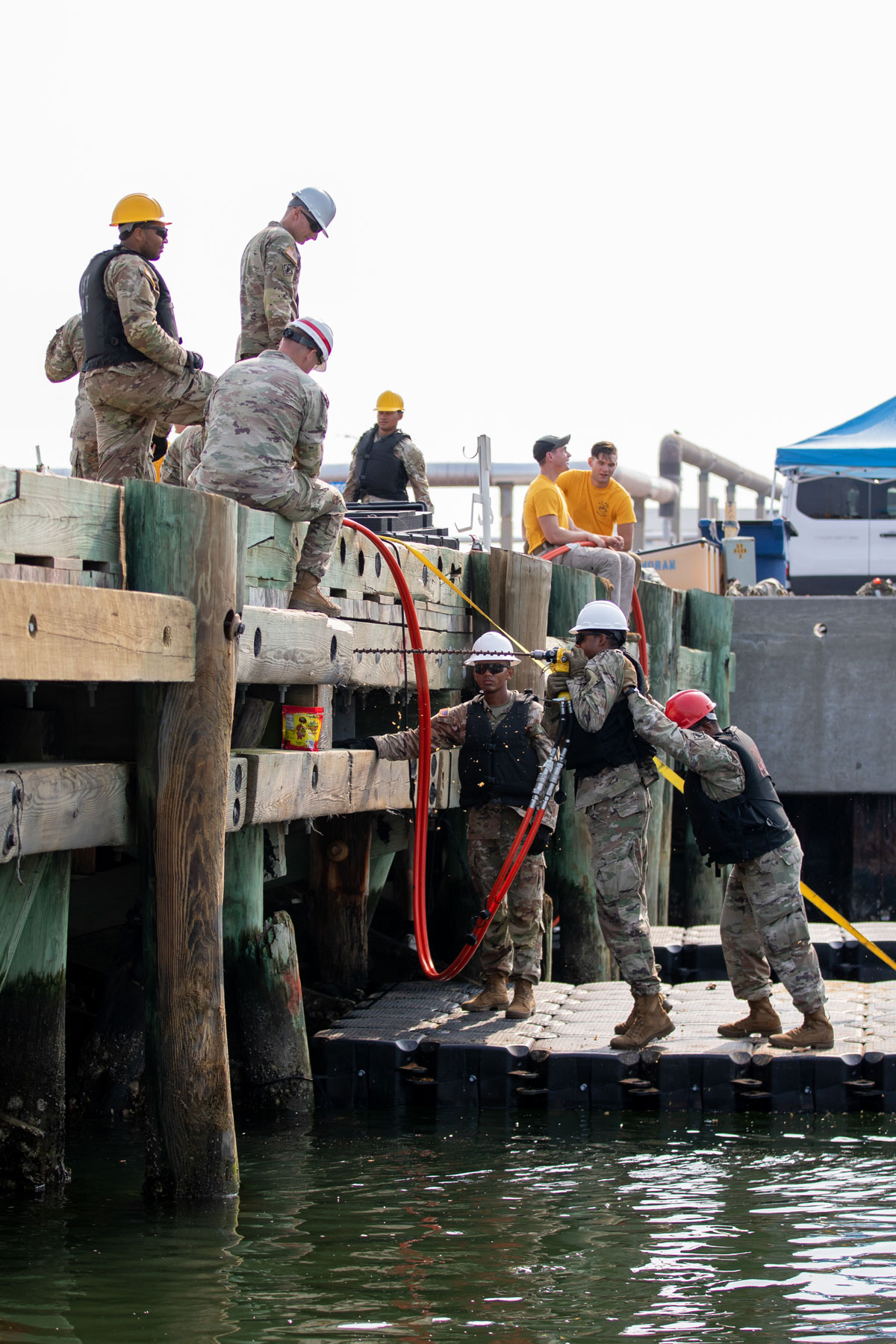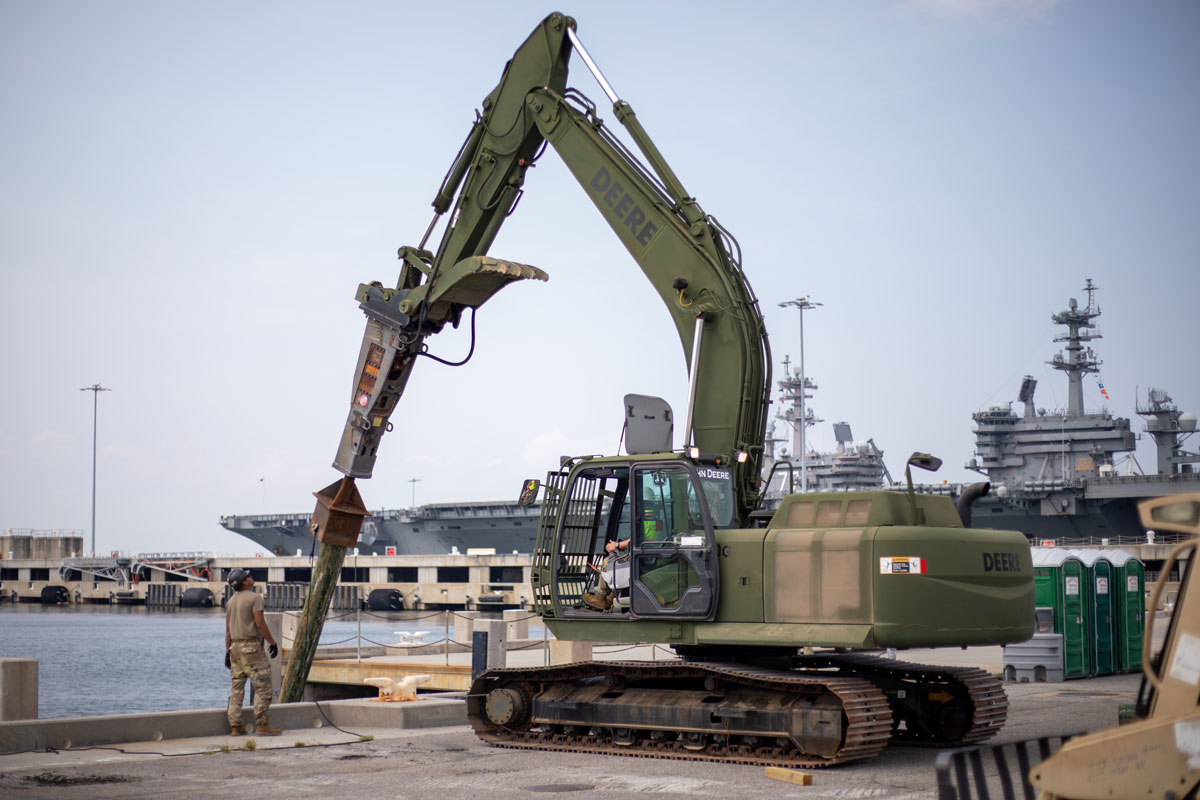Operation Turning Point
By Captain Matias K. Sejersen
Article published on: January 1, 2024 in the Engineer 2024 Annual Issue
Read Time: < 11 mins
DOI: https://doi.org/10.21236/AD1307132

The 92d Engineer Battalion, Fort Stewart, Georgia, participated in the first of a series of battalion level exercises as part of Operation Turning Point. The exercise focused on improving port damage repair (PDR) capabilities and offered valuable lessons in the planning and execution of this type of mission.
Each battalion within the 20th Engineer Brigade, Fort Liberty, North Carolina, is responsible for a distinct general engineering capability; the 92d Engineer Battalion develops the XVIII Airborne Corps PDR capability. Although PDR is a defined mission-essential task for the engineer dive detachments (EDDs) assigned to the 92d Engineer Battalion, there is an institutional knowledge and experience gap with regard to PDR.
Planning and Coordination
Three primary goals of the exercise were to—
- Exercise the ability of the battalion to conduct expeditionary deployment operations of heavy construction and diving assets.
- Test and continue to improve the ability of the engineer construction company (ECC) to conduct pile-driving operations in a marine environment.
- Refine EDD and ECC tactics, techniques, and procedures for conducting carpentry repair work of waterfront facilities in concert with one another.
These goals led to the requirement for a training location that was geographically separated from the EDD/ECC home station, included waterfront facilities in need of repair, and fell under the control of an organization receptive to hosting the exercise.

Soldiers perform carpentry work on a timber chalk.
Training Area Selection
Pier F, Naval Station Norfolk, Virginia, was identified as an ideal training location for the exercise. The timber pier was in need of extensive carpentry repair work for a return to full operational capacity, and it is located adjacent to a suitable staging area. Because the owning organization, Naval Facility Systems Engineering Command (NAVFAC), Washington Navy Yard, Washington, D.C., was interested in having the pier repaired, there were no construction material costs to the battalion. Planners from the 92d Engineer Battalion took advantage of the opportunity to conduct joint PDR skill set training alongside Naval Mobile Construction Battalion Eleven (NMCB 11), Gulfport, Mississippi, which regularly conducts PDR training near Gulfport. Following the training, Pier F and adjacent piers of differing construction types remain suitable training areas for future battalion PDR exercises, as considerable carpentry and pile work must yet be done to return the piers to their full operational capacity.
Funding
Because the line haul of heavy construction equipment from Fort Stewart to Naval Station Norfolk would be prohibitively expensive, the 92d Engineer Battalion requested that the 7th Transportation Brigade (Expeditionary), Fort Eustis, Virginia, provide assistance in the form of a sealift from Blount Island, Florida, directly to Naval Station Norfolk; the 7th Transportation Brigade was able to fulfill this request at no cost to the 92d, as that voyage was classified as a training sail. Coordination of this movement particularly for the use of the Blount Island facility as an upload point—was cumbersome and dependent on the good faith of several officers and civilians external to the 20th Engineer Brigade. However, the movement provided 92d Engineer Battalion leaders and equipment operators with valuable experience in maritime roll-on/roll-off transportation operations. And although the movement was ultimately successful, the assignment of a dedicated mobility warrant officer to the 20th Engineer Brigade would support battalion representatives coordinating with organizations outside the chain of command for movement support and provide the knowledge and expertise necessary for movements other than convoys and line hauls. The 7th Transportation Brigade frequently executes training voyages that may align with future iterations of 92d Engineer Battalion PDR exercises and has expressed a willingness to provide support in the future; therefore, the 92d will continue to maintain a close working relationship with the 7th Transportation Brigade in order to draw upon that watercraft support.

Soldiers assigned to the 554th ECC perform work on a floating platform, illustrating the difficulties caused by rising and falling tides.
Contracting
Due to the off-post location of the exercise and the cost of movement, the 92d Engineer Battalion decided to pursue contracting solutions for the crane support required for the placement of timber piles before the piles could be driven with the ECC hydraulic excavator (HYEX). The U.S. Army Mission and Installation Contracting Command (MICC) at Fort Stewart initially directed the battalion to the U.S. General Services Administration for equipment rental. However, unit research indicated that there were no General Services Administration rentals available so the unit again consulted with MICC. Following the consultation, the battalion performed market research and submitted initial requirements to MICC—but this was within 90 days of execution. Due to the shortened timeline, MICC was unable to execute completed contracts prior to the start of the exercise. A final effort to contract for a crane was made through the supporting NAVFAC office—but that effort was also unsuccessful, as it was undertaken too late in the planning process. In the end, the exercise provided an opportunity to prove that a single HYEX can be used to place and drive piles; however, the operation is imprecise and slow. Additionally, in real-world contingency operations, ECC personnel will likely be moved many days ahead of their heavy equipment. For future exercises, the battalion will continue to refine the process of placing and driving timber piles with one HYEX, using divers, formwork, or a combination of the two to improve precision. Additionally, the staff will engage a supporting contracting officer to determine the feasibility of developing a generic contract for heavy equipment (crane and excavator) support, which the battalion may tailor and execute for future exercises or contingency operations where ECC personnel find themselves deployed ahead of their equipment.
Pile Driving
Due to the lack of contracted crane support for placing piles and the unavailability of material-handling equipment suitable for loading the ECC HYEX onto the NAVFAC provided floating platforms, piles could not be driven directly adjacent to Pier F (to replace the fendering system, which protects the structure from impacts), as had originally been planned. Instead, ECC personnel drove a single test pile from the wharf, with the primary goal of determining if the HYEX—equipped with a custom-fabricated pile-driving attachment—could be used to place and drive piles. Absent any diver support or formwork, the operation was cumbersome and imprecise. It also required modification of the pile driver; a pin was needed to fix the end of the pile to the driving attachment—an arrangement that is likely to destroy the driving attachment over time. The driving attachment performed well, as a pointed timber pile was driven to a target embedment depth of 10 feet. Future exercises will involve experimentation with the use of square rather than pointed piles and with various ways to precisely place timber piles before they are driven by the HYEX with driver attachment, which should be accompanied by a second piece of equipment—preferably a crane, due to the extended reach, but possibly a second HYEX. A dedicated maneuverable floating platform must be available for the HYEX with pile-driving equipment so that it is capable of accessing the entire worksite. In addition, unless the pile-placing equipment consists of a very large, long-reach crane located on the wharf end of the pier, it must also be placed on a floating platform. Experimentation will also be conducted on the use of divers and formwork to ensure that the pile is correctly placed before it is driven. An even better solution would be the acquisition of a crane- or excavator-mounted vibratory pile driver that is compatible with battalion organic equipment; this would allow a single piece of equipment to efficiently place and drive the pile, entirely removing the need for the second piece of equipment. Under this configuration, piles would be fixed to the vibratory driver by a single-point chain sling and hoisted into position, where divers or pier-side personnel would guide them to their precise locations. The vibratory driver could then be used to “pull” the pile through the first several inches of embedment via the single-point sling to fix the pile in place before support personnel released the sling and allowed the driver to be placed on top of the pile to drive it to the desired embedment depth. Any of the techniques discussed will require that a unit conducting PDR maintain a population of proficient crane operators, load riggers, and supervisors to safely place and drive timber piles. Engineer units might consider that, as part of Advanced Individual Training for Military Occupational Specialty (MOS) 88Hs–Cargo Specialists, the 58th Transportation Battalion, Joint Base Langley-Eustis (JBLE), Virginia, conducts training on the operation of large cranes in maritime environments. Those instructors may be able to provide valuable knowledge beyond the scope of the Crane Operator’s Course offered by the U.S. Army Engineer School (USAES), Fort Leonard Wood, Missouri, to engineer units seeking to train operators to rig and lift unusually shaped loads in a marine environment.

A Soldier uses a HYEX to drive a timber pile at Naval Station Norfolk.
Operations
Personnel from the 511th EDD, JBLE, and 526th ECC, Fort Stewart, assisted NMCB 11 personnel with the construction of an earth-filled sheet pile pier during a Gulfport, Mississippi, iteration of Operation Turning Point. This experience familiarized 92d Engineer Battalion and subordinate personnel with Navy tactics, techniques, and procedures for waterfront construction, which will, in turn, improve the battalion’s own capability. The most notable technique learned was that for the employment of long-reach hydraulic excavators. This equipment is nearly identical to the Army ECC HYEX—except that the boom has been replaced with either a long (or extended)-reach version, allowing greater flexibility in placing the equipment to perform work. In the context of waterfront construction, such a substitution would allow a floating HYEX to access a larger work area from a stationary platform, thereby reducing the time spent repositioning and anchoring the platform. It would also allow a HYEX to drive piles to a greater depth of embedment than is possible with a standard-reach boom, as the driving attachment could be hoisted to a greater initial height. This would be especially useful in driving structural piles (as opposed to fender piles), where a specific depth of embedment must be reached in order to attain the required bearing capacity. NMCB 11 personnel also made use of a standard vibratory pile-driving attachment optimized for driving sheet piles. This equipment offers the capability of building waterfront facilities of an entirely different construction type earth-filled sheet pile piers or wharves. These structures are simple to construct (due to a lack of horizontal and diagonal cross bracing), have highly customizable geometry, and—if a sufficient supply of sheet piles is available—can be constructed using local materials for backfill. This construction method is further simplified by the fact that airfield damage repair tactics, techniques, and procedures already established by the 20th Engineer Brigade could easily be applied to designing and constructing the backfill components of the structures. The 92d Engineer Battalion will continue to focus on improving timber pile construction capabilities but should consider sheet pile construction as a goal for future development. Specific consideration should be given to pile-driving attachments that can drive both cylindrical and sheet piles.
Replacement of Timber Components
ECC and EDD personnel worked next to and beneath the pier to replace timber diagonal cross bracing and pile- bracing members. To access their respective work areas, the units used reconfigurable floating docks, which can be formed into narrow sections capable of accessing the underside of the pier between the pile bents. These floating docks performed very well and provided a stable and maneuverable work platform. Leaders developed an efficient and scalable task organization for this type of work comprised of dedicated demolition and installation teams for each work area, dedicated preparation teams that prepared new timber members for the work areas, a single extraction team that removed old timber from both work areas, and—in this case—two separate command and control nodes. While performing the shore-side carpentry work of preparing timber elements for installation, gasoline-driven and electric tools performed very well; however, leaders should take adequate precautions when utilizing these tools on platforms floating over water, where hydraulic or pneumatic tools are generally considered safer. To maximize efficiency, each team performing work on a timber pier (cross bracing, fendering, decking/curbs) requires at least two hydraulic power units—one for demolition work and one for installation work. Sharing two hydraulic power units between the ECC and EDD installation teams led to bottlenecking at several times. Between the hydraulic power units organic to the ECC and EDD and the auxiliary hand tool hydraulic ports on some pieces of heavy equipment, sufficient equipment exists to perform meaningful carpentry repair work without any augmentation. These assets will be integrated into future battalion PDR exercises to increase the scope of work performed.
Command and Control
Due to the lack of work that required efforts both above and below the waterline, there was little direct collaboration between ECC and EDD personnel on-site. Each unit worked according to plans developed and managed by their own command team. On a large project or one requiring the efforts of topside and diving construction personnel in concert (such as the precise driving of timber piles), a higher-level command and control node would be appropriate. In future exercises, the battalion command and control element will deploy to the construction site so that the construction operation cell can control the construction activities of multiple companies.
Conclusion
The staff of the 92d Engineer Battalion coordinated with external organizations for support during a PDR exercise of Operation Turning Point. NAVFAC, the owner of Pier F at Naval Station Norfolk, was the primary external stakeholder for the project. That agency, in turn, also acted as a liaison with other entities on Naval Station Norfolk, assisting the 92d with procuring local support and services necessary for successful execution of the exercise. Future iterations of this exercise are expected to lead to increased skill and efficiency of equipment operators, construction supervisors, supporting staffs, and unit commanders in their execution of the PDR mission.
Author
Captain Sejersen is the commander of the 74th EDD. He previously served as an assistant operations officer with the 92d Engineer Battalion and as the executive officer of the 86th EDD, JBLE. He holds a bachelor’s degree in civil and environmental engineering from Villanova University, Pennsylvania, and is currently pursuing a master’s degree in civil engineering with a focus on marine and coastal engineering from Johns Hopkins University, Baltimore, Maryland.